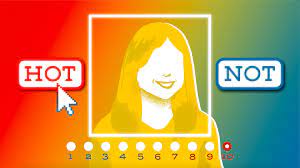Introduction
In the age of social media and digital technology, the concept of "Hot or Not" has taken on a new dimension. What was once a casual conversation among friends has transformed into a global phenomenon, where individuals are rated and ranked based on their appearance by strangers online. This article explores the evolution of the "Hot or Not" phenomenon, its impact on society, and the underlying psychological and societal factors that drive it.
The Birth of "Hot or Not"
The roots of "Hot or Not" can be traced back to a website that was launched in 2000 by two friends, James Hong and Jim Young. The website allowed users to upload photos of themselves or others, which would then be rated by other users on a scale from 1 to 10 based solely on their physical appearance. This simple concept quickly gained popularity, and within months, it had millions of users.
The website's success can be attributed to several factors. Firstly, it tapped into our innate human curiosity and desire for validation. People have always been interested in how they are perceived by others, and "Hot or Not" offered a quantifiable way to measure that perception. Secondly, it leveraged the power of the internet to connect people from all over the world, allowing for a diverse range of opinions and ratings.
The Social Media Revolution
While the original "Hot or Not" website eventually faded into obscurity, its legacy lived on in the social media era. With the rise of platforms like Facebook, Instagram, and Tinder, the rating and ranking of individuals based on their appearance became more pervasive than ever. Users could now post photos and receive likes, comments, and even direct messages from strangers, all of which served as a form of validation or rejection.
Social media platforms, particularly Instagram, played a significant role in shaping contemporary beauty standards. The platform's emphasis on visual content and the curated images of influencers and celebrities created an idealized version of beauty that many aspired to emulate. Filters, photo-editing tools, and cosmetic surgery became means to conform to these standards.

The Psychological Impact
The "Hot or Not" phenomenon, whether on dedicated websites or social media, has profound psychological implications. It can lead to both positive and negative outcomes for individuals.
Positive aspects of the phenomenon include a boost in self-esteem and self-worth when receiving positive feedback and validation from others. It can also serve as a form of self-expression and creativity for those who use social media to showcase their unique style and personality.
However, the negative aspects cannot be ignored. For many, the constant pursuit of external validation through likes and comments can lead to anxiety, depression, and low self-esteem when expectations are not met. It can also foster a sense of inadequacy and self-comparison, as individuals strive to match the idealized beauty standards promoted on social media.
The Impact on Society
The "Hot or Not" phenomenon also has broader societal implications. It reinforces and perpetuates traditional beauty standards that often exclude diverse forms of beauty. People who do not conform to these standards may feel marginalized and excluded, leading to body image issues and self-doubt.
Moreover, it contributes to a culture of superficiality, where appearances are prioritized over character, intelligence, and talent. This can have a detrimental effect on relationships and human connections, as people are often judged solely on their looks rather than their inner qualities.
The objectification of individuals in the pursuit of "Hot or Not" ratings also raises ethical concerns. It can lead to online harassment, cyberbullying, and the invasion of privacy. In extreme cases, it can even lead to dangerous offline consequences, such as stalking or harassment.
The Role of Social Media Companies
Social media companies bear a significant responsibility in shaping and moderating the "Hot or Not" phenomenon. Many platforms have taken steps to address the negative consequences of their services. For example, Instagram has introduced features like hiding likes and implementing strict community guidelines to combat bullying and harassment.
However, critics argue that more needs to be done to regulate and mitigate the harmful effects of online rating and ranking. Stricter rules regarding the posting of explicit or offensive content and the promotion of unrealistic beauty standards are proposed as potential solutions.
Promoting Positive Change
To mitigate the negative impact of the "Hot or Not" phenomenon, it is essential to promote a more positive and inclusive online culture. Here are some steps individuals and society can take:
- Promote self-acceptance: Encourage individuals to value themselves for who they are rather than seeking validation from others. Building self-esteem based on internal qualities is crucial.
- Media literacy: Educate people, especially young users, about the deceptive nature of social media and the prevalence of photo editing. Teach them to critically analyze the content they consume.
- Diverse representation: Advocate for diverse beauty standards in media and advertising. Celebrate and support campaigns and initiatives that showcase various forms of beauty.
- Online kindness: Encourage online etiquette and kindness. Remind individuals that there is a real person behind every profile picture, deserving of respect.
- Mental health support: Ensure that resources and support are readily available for individuals who experience negative mental health consequences due to online validation seeking.
Conclusion
The "Hot or Not" phenomenon, born in the early days of the internet, has evolved and taken on new dimensions in the age of social media. While it can provide positive validation and creative expression, it also has the potential to harm mental health, reinforce unrealistic beauty standards, and contribute to a culture of superficiality.
It is up to individuals, social media companies, and society at large to shape the impact of the "Hot or Not" phenomenon. By promoting self-acceptance, media literacy, diverse representation, online kindness, and mental health support, we can work toward a digital landscape that values people for who they are rather than how they look. In doing so, we can foster a more inclusive and positive online culture for generations to come.


